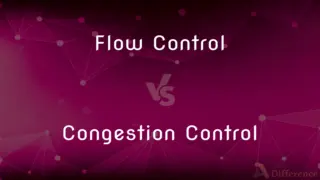Kanji vs. Katakana — What's the Difference?
By Tayyaba Rehman — Published on January 30, 2024
Kanji are complex characters derived from Chinese, representing whole words or concepts, while Katakana is a simpler, phonetic script used mainly for foreign words in Japanese.

Difference Between Kanji and Katakana
Table of Contents
ADVERTISEMENT
Key Differences
Kanji is a set of characters in the Japanese writing system, originally borrowed from Chinese. Each Kanji represents a word or concept. Katakana, on the other hand, is one of Japan's two kana systems, used primarily to write foreign loanwords, technical and scientific terms, and for emphasis.
Kanji characters are complex and can have multiple pronunciations and meanings, depending on context. Katakana characters are simpler and more angular in appearance, representing individual sounds and having no inherent meaning.
The usage of Kanji allows for concise writing and is fundamental in understanding Japanese literature and official documents. Katakana is used for non-Japanese names, onomatopoeia, and the transcription of foreign words into Japanese.
Learning Kanji is considered more challenging due to the vast number of characters and their variations. Katakana, with a set of about 46 characters, is relatively easier to learn and often taught to beginners early in their study of Japanese.
In modern Japanese texts, Kanji and Katakana are used alongside Hiragana (another kana system), with each script serving specific functions for clarity and readability. The integration of these scripts is a distinctive feature of written Japanese.
ADVERTISEMENT
Comparison Chart
Origin
Borrowed from Chinese
Indigenous Japanese script
Function
Represents words or concepts
Represents sounds, used for foreign words
Complexity
Complex characters with multiple readings
Simpler, more angular characters
Usage
Literature, official documents
Foreign names, technical terms, emphasis
Learning Difficulty
High, due to the number of characters
Relatively easier, with a fixed character set
Compare with Definitions
Kanji
Characters representing words or concepts.
The Kanji 水 means water.
Katakana
Phonetic script for foreign words.
コンピュータ in Katakana means computer.
Kanji
Derived from Chinese characters.
Many Kanji have retained their original Chinese meanings.
Katakana
Simple, angular characters.
Katakana is distinct for its straight lines and sharp angles.
Kanji
Used in formal and literary texts.
Kanji are prevalent in official Japanese documents.
Katakana
Contains about 46 characters.
Katakana is often one of the first scripts learned in Japanese.
Kanji
Integral to the Japanese writing system.
Understanding Kanji is crucial for fluency in Japanese.
Katakana
Used for emphasis and technical terms.
Scientific terms are often written in Katakana.
Kanji
Can have multiple pronunciations.
The Kanji 生 can be read as sei or shō.
Katakana
Complements Kanji and Hiragana in writing.
Katakana is used alongside other Japanese scripts in text.
Kanji
A Japanese system of writing based on borrowed or modified Chinese characters.
Katakana
A relatively angular kana used especially to write foreign words, onomatopoetic words, and the names of plants and animals in Japanese.
Kanji
A character used in this system of writing.
Katakana
(uncountable) A Japanese syllabary used when writing words borrowed from foreign languages other than Chinese, specific names of plants and animals and other jargon, onomatopoeia, or to emphasize a word or phrase. Also used to write the Ainu language.
Kanji
(uncountable) The system of writing Japanese using Chinese characters.
Japanese is written in a mixture of kanji and kana.
Katakana
A character thereof.
Kanji
Any individual Chinese character as used in the Japanese language.
I know about a thousand kanji.
Common Curiosities
Are Kanji characters the same as Chinese characters?
They originated from Chinese characters but are used differently.
Can Kanji have different meanings?
Yes, depending on context and pronunciation.
Is Katakana easier to learn than Kanji?
Yes, due to its smaller set of characters and simpler form.
What are Kanji used for in Japanese?
Representing words and concepts.
What is an example of a word written in Katakana?
"アメリカ" (Amerika) for "America."
Are foreign names written in Kanji?
Generally, they are written in Katakana.
Why is Katakana used?
Mainly for foreign words and technical terms.
How many Kanji characters are there?
Thousands, with a few thousand commonly used.
Can Kanji be omitted in writing?
Sometimes, especially in informal texts, but it can change the text's formality and clarity.
Do Japanese children learn Kanji or Katakana first?
They usually learn Hiragana first, then Katakana, followed by Kanji.
Is Katakana used in everyday writing?
Yes, particularly for borrowed words and emphasis.
Why might a Japanese text use both Kanji and Katakana?
For clarity, with Kanji for native words and Katakana for foreign or emphasized terms.
Is Katakana used in formal documents?
Rarely, it's more common in informal contexts.
Do Kanji characters have only one pronunciation?
No, many have multiple readings.
Do Kanji and Katakana serve the same purpose?
No, they have distinct roles in the Japanese writing system.
Share Your Discovery

Previous Comparison
Flow Control vs. Congestion Control
Next Comparison
Albinism vs. MelanismAuthor Spotlight
Written by
Tayyaba RehmanTayyaba Rehman is a distinguished writer, currently serving as a primary contributor to askdifference.com. As a researcher in semantics and etymology, Tayyaba's passion for the complexity of languages and their distinctions has found a perfect home on the platform. Tayyaba delves into the intricacies of language, distinguishing between commonly confused words and phrases, thereby providing clarity for readers worldwide.












































